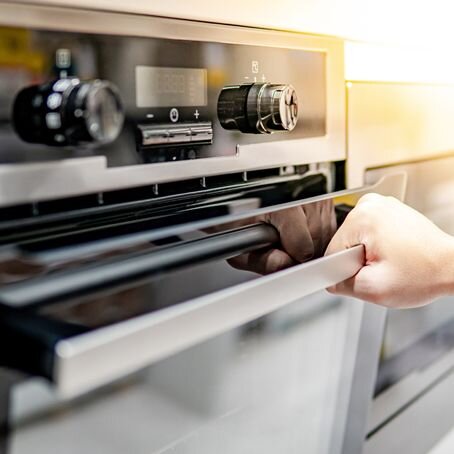How to Clean a Natural Gas Oven and Stovetop
04/12/2024

In today’s busy world, it’s easy to see how cleaning a natural gas oven doesn’t always make the top of everyone’s to-do list. But it shouldn’t be overlooked. Experts recommend cleaning a gas oven three to four times a year to maintain kitchen hygiene, appearance, safety and cooking efficiency. This week, we’ll take a closer look at the best ways to clean your gas oven and cooktop.
Cleaning Solutions For Natural Gas Ovens
Before you start, you’ll need to select your preferred cleaning solution. There are dozens of commercial brands available in the cleaning section of your local at home-improvement or grocery store. And these can be especially good at removing tough, greasy stains in a relatively short amount of time. But if you’re cringing at the thought of all those chemicals in your oven, there are greener options as well.
How to Clean a Gas Oven Naturally
If you're looking for a way to clean your gas oven without chemicals, it's easy to create a homemade solution. Mix a little baking soda and water together to create a thick, spreadable paste that can be applied to the areas you want to clean. When it’s time to clean and remove the paste, an equal mixture of vinegar and water will help make short work of the task.
Steps For Cleaning Natural Gas Ovens
- Once you’ve got your preferred cleaning solution sorted out, you can begin removing the oven’s racks, trays and other accessories, which you can then soak in warm, soapy water to make cleaning them easier later in the process. Make sure your oven is off and that there are no hot surfaces before you begin.
- Prepare your cleaning solution (if homemade) and begin applying it to the inside of your oven, focusing on areas with heavy buildup, spills or stains—and don’t forget the inside of the door. Spread your solution evenly with a soft brush, sponge or cloth.
- Let your solution sit for a spell. For store-bought cleaners, the directions on the bottle or container should say how long is best. For homemade solutions, allow the paste to sit for a minimum of 30 minutes--12 hours overnight is recommended.
- While you’re waiting for your cleaning solution to do its thing, remove your racks, trays and oven accessories from the soapy water and begin scrubbing them with a brush or rag. Once clean, set them aside to dry before returning them to the oven.
- When it’s time to clean up the solution that’s been sitting, use a brush or non-abrasive scrubbing pad to wipe up the mess. If you’ve used a homemade cleaning solution made from baking soda, be sure you use the vinegar and water mixture mentioned above to aid in the cleanup.
- When the inside of the oven is clean, replace its racks, trays and accessories—which should already be dry.
Steps For Cleaning Natural Gas Oven Stovetops
- When it’s time for a stovetop deep-clean (beyond everyday wipe-downs), the stove should be off as well as the gas supply that feeds its flames. Most natural gas ovens and stoves have a gas shut-off valve located behind the appliance—on the wall, floor or in a nearby cabinet. Check your appliance user manual or consult a professional if you’re unsure. Typically, turning the valve clockwise will shut the gas supply off.
- Double check that you’ve turned the gas off by trying to turn on one of the burners. If it doesn’t ignite and produce a flame, your gas has been shut off—it’s always good to open a window during this step to ensure there aren’t any residual gas fumes left lingering in the kitchen.
- Carefully lift and remove your stove’s burner caps and grates. Soak them in warm, soapy water for about 30 minutes.
- Inspect your burner heads for debris—food, grease or other contaminants. If they’re dirty, you can gently scrub them with a soft, dry brush (old toothbrushes work great) to remove any unwanted buildup or material. If you notice that any of your burner ports are clogged, use a pin or needle to carefully clear them out as well.
- Scrub your burner caps and grates you’ve had soaking. Then dry them thoroughly and begin replacing them back onto the stove—taking care that everything is properly placed and aligned.
- Turn your gas supply and oven back on and begin testing each burner to make sure they ignite properly and produce a flame.
Want more on natural gas ovens and stoves?
As Georgia’s most-trusted natural gas provider, we get all types of questions related to natural gas around the home, and we’re pleased to provide helpful information and tips. If you want to know more about natural gas ovens and stoves in general, check out our informative blog: Natural Gas Stoves: Everything You Need to Know.
 Help
Help Giving Back
Giving Back My Account
My Account Sign Up
Sign Up










